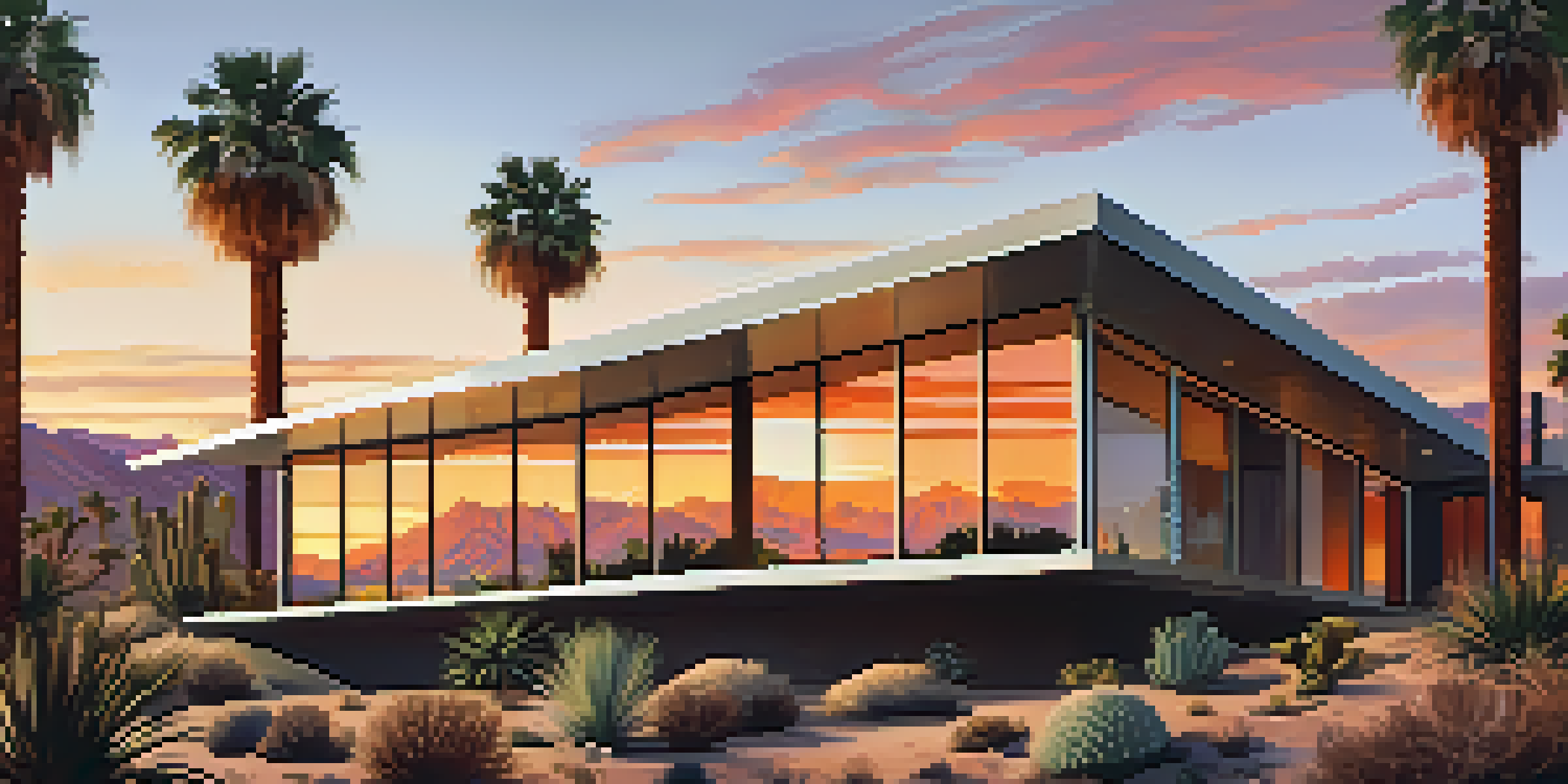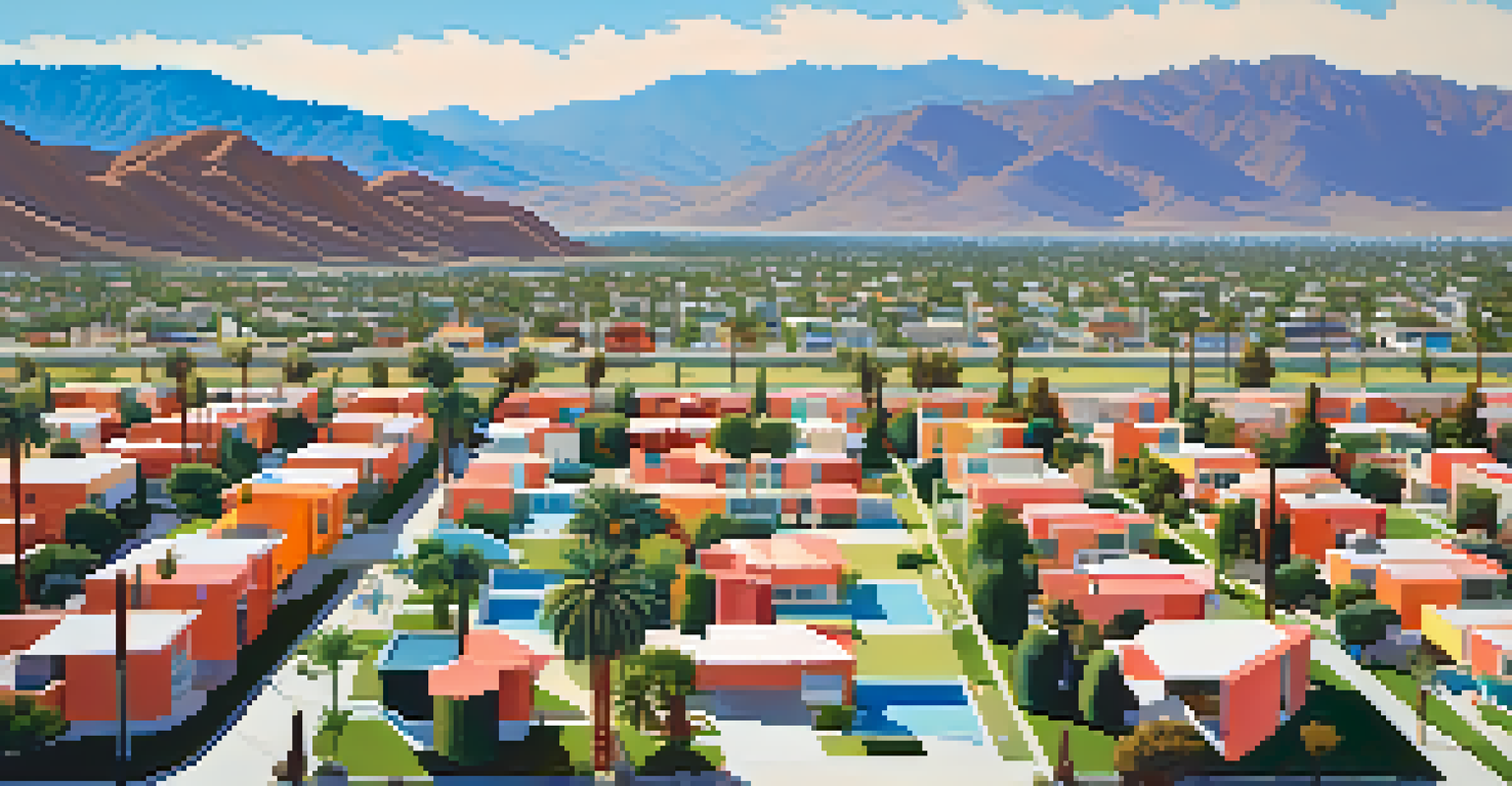How Palm Springs Became a Hub for Mid-Century Modern Design

The Birth of Mid-Century Modern Design in Palm Springs
Mid-century modern design emerged in the mid-20th century, characterized by clean lines, organic forms, and a connection to nature. In Palm Springs, this style found fertile ground due to the area's unique desert landscape and favorable climate. Architects and designers sought to create homes that blended seamlessly with their surroundings, using large windows and open spaces to invite the outdoors in.
Architecture is the thoughtful making of space.
The appeal of Palm Springs as a retreat for Hollywood's elite further propelled the movement. Celebrities like Frank Sinatra and Marilyn Monroe sought out these stylish homes, helping to popularize the mid-century modern aesthetic. Their influence helped shape the architectural landscape, making it a desirable destination for those looking to experience this innovative design firsthand.
As the mid-century modern movement flourished, Palm Springs became synonymous with this style. The city’s architecture reflected a desire for leisure and relaxation, aligning perfectly with the lifestyle of its inhabitants. Thus, the foundation was laid for Palm Springs to become a beacon of mid-century modern design.
The Influence of Notable Architects
Palm Springs attracted numerous influential architects, each contributing their unique vision to the city's architectural tapestry. Notable figures like Richard Neutra, Albert Frey, and Donald Wexler designed iconic homes that showcased the principles of mid-century modernism. Their innovative designs often featured flat planes, large glass windows, and open spaces that emphasized the natural beauty surrounding them.

Richard Neutra's Kaufmann Desert House is a prime example of this architectural movement. The house's integration with the landscape and its striking design have made it a timeless symbol of mid-century modern architecture. Similarly, Frey's work on the Palm Springs City Hall reflects the region's commitment to blending modern design with functionality.
Palm Springs: Mid-Century Hub
The city became a focal point for mid-century modern design, attracting influential architects and celebrities who shaped its architectural identity.
These architects not only shaped the physical landscape but also inspired a generation of designers. Their commitment to modernism’s ideals established Palm Springs as a hub where innovative architecture could thrive, attracting both residents and tourists alike.
The Role of the Desert Landscape
The unique desert environment of Palm Springs played a crucial role in the development of mid-century modern design. With its stunning views, natural light, and striking sunsets, the landscape inspired architects to create designs that harmonized with their surroundings. This connection to nature is a hallmark of mid-century modern homes, which often feature expansive windows and outdoor living spaces.
Good design is obvious. Great design is transparent.
Architects capitalized on the desert's beauty by using materials like stone and wood that blended seamlessly into the environment. These materials not only complemented the natural landscape but also provided a sense of warmth and comfort. The result was homes that felt like extensions of the desert itself, rather than separate entities.
In this way, the desert landscape became an essential element of the mid-century modern aesthetic in Palm Springs. It informed design choices and fostered a lifestyle that celebrated both architecture and nature, creating a harmonious living experience.
The Impact of the Post-War Boom
Following World War II, the United States experienced a significant economic boom, leading to increased demand for housing. Palm Springs, with its idyllic climate and proximity to Los Angeles, became a popular destination for those seeking a second home or vacation property. This influx of residents and tourists created a ripe environment for mid-century modern architecture to flourish.
Developers recognized the opportunity and began constructing neighborhoods filled with modernist homes designed for leisure and relaxation. These homes were often marketed to the burgeoning middle class, showcasing affordable luxury that was accessible to many. The result was a wave of new construction that transformed the area into a mid-century modern paradise.
Desert Landscape as Inspiration
The unique desert environment influenced architects to create homes that harmonized with nature, featuring expansive windows and outdoor spaces.
This post-war boom solidified Palm Springs' reputation as a center for modern design. It not only changed the architectural landscape but also established a lifestyle that emphasized leisure, beauty, and community.
Cultural Influences and Artistic Expression
The mid-century modern movement in Palm Springs was not only about architecture but also encompassed a broader cultural shift. The era was marked by a sense of optimism and creativity, reflected in the art and design of the time. Artists and designers collaborated, leading to a vibrant cultural scene that celebrated innovation and artistic expression.
Palm Springs became a gathering place for creative minds, with events like the Palm Springs Art Museum showcasing contemporary art alongside mid-century works. This interaction between art and architecture enriched the city's aesthetic, creating an environment where design was celebrated and appreciated. Public art installations and unique design elements became integral parts of the city's landscape.
As a result, Palm Springs emerged as a cultural hub, attracting visitors not just for its architecture but also for its vibrant artistic community. This blend of culture and design made the city a unique destination, further enhancing its reputation as a center for mid-century modernism.
Preservation Efforts and Modern Revival
In recent years, there has been a growing appreciation for mid-century modern architecture, leading to preservation efforts in Palm Springs. Residents and local organizations have worked diligently to protect these historic homes from demolition and neglect. This commitment to preservation has ensured that future generations can experience the beauty and significance of mid-century modern design.
Events like Modernism Week celebrate this architectural heritage, drawing enthusiasts from around the world. During this week-long event, visitors can tour iconic homes, attend lectures, and engage with designers and architects. It's a celebration of the style that has defined Palm Springs and a testament to the city's dedication to preserving its unique identity.
Revival and Preservation Efforts
Recent preservation initiatives celebrate mid-century modern architecture, ensuring that Palm Springs' rich design legacy is maintained for future generations.
These preservation efforts not only honor the past but also contribute to the ongoing revival of mid-century modernism. By fostering a deeper understanding and appreciation of this design movement, Palm Springs continues to attract new residents and visitors who are drawn to its rich architectural history.
The Future of Mid-Century Modern in Palm Springs
As Palm Springs continues to evolve, the future of mid-century modern design remains bright. New developments are being designed with an eye toward the past, often incorporating elements of mid-century aesthetics while embracing modern technologies. This balance between honoring tradition and embracing innovation ensures that the city's architectural character will endure.
Moreover, the community's commitment to design excellence is evident in ongoing discussions about urban planning and development. Residents and city officials are increasingly aware of the importance of preserving the mid-century modern legacy while accommodating new growth. This proactive approach is vital in maintaining the unique charm that attracts visitors and residents alike.

Ultimately, Palm Springs stands as a testament to the enduring appeal of mid-century modern design. As the city navigates the future, it will surely continue to celebrate its rich architectural heritage while adapting to the needs of a new generation.